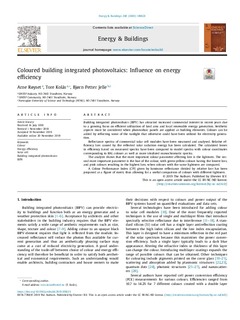Coloured Building Integrated Photovoltaics: Influence on Energy Efficiency
Journal article, Peer reviewed
Published version
Permanent lenke
http://hdl.handle.net/11250/2633041Utgivelsesdato
2019Metadata
Vis full innførselSamlinger
- Publikasjoner fra CRIStin - SINTEF AS [5801]
- SINTEF Community [2247]
- SINTEF Industri [1566]
Sammendrag
Building integrated photovoltaics (BIPV) has attracted increased commercial interest in recent years due to a growing focus on efficient utilization of land area and local renewable energy generation. Aesthetic aspects must be considered when photovoltaic panels are applied as building elements. Colours can be added by reflecting some of the sunlight that otherwise could have been utilized for electricity generation.
Reflectance spectra of commercial solar cell modules have been measured and analysed. Relative efficiency loss caused by the reflected solar radiation energy has been calculated. The calculated losses in efficiency based on measured spectra have been compared to model spectra with colour coordinates corresponding to RAL colours as well as more idealized monochromatic spectra.
The analysis shows that the most important colour parameter affecting loss is the lightness. The second most important parameter is the hue of the colour, with green-yellow colours having the lowest loss, and pink colours resulting in the highest loss, when colours with the same lightness are compared.
A Colour Performance Index (CPI) given by luminous reflectance divided by relative loss has been proposed as a figure of merit, thus allowing for a useful comparison of colours with different lightness.

